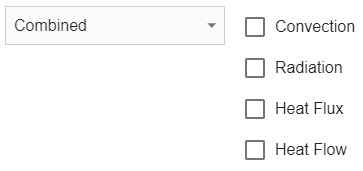Boundary conditions
Boundary conditions (BC) are physical definitions on domain boundary surfaces for thermal conditions and electromagnetism. Here are listed all boundary conditions used in CENOS, as well as the most common usage for each BC.
Thermal BC
Thermal BC's are boundary conditions through which the heat exchange between domains is defined.
Fixed temperature
Fixed temperature boundary condition defines a fixed temperature on the boundary surface.

Usage: When Motion is used on infinite billet, the surface through which the billet enters the computational domain can be defined with Fixed Temperature.
Heat flux
Heat flux boundary condition defines a constant heat flux density on the boundary surface.

Usage: Can be used if the heat flux going through a specific area is known
Heat flow
Heat flow boundary condition defines a constant heat flow (in watts) on the boundary surface.

Usage: Can be used if the heat flow going through a specific area is known
Convection
Convection boundary condition defines the heat flux as dependent from the ambient temperature and heat transfer coefficient. Convection is defined as:

Usage: Convection is used on workpiece-air interface to define heat exchange when temperature is low. Usually used together with Radiation.
To learn more about Convection definition, click here.
Radiation
Radiation boundary condition defines the thermal radiation to infinity on the boundary surface, where the heat flux is defined as:

Usage: Radiation is used on workpiece-air interface to define heat exchange when temperature is high. Usually used together with Convection.
To learn more about Radiation definition, click here.
Combined
Combined boundary condition allows to combine multiple BC such as Convection, Radiation, Heat Flux and Heat Flow on a single domain surface.

Usage: Combined is used on workpiece-air interface to define both Convection and Radiation for a complete heat trasfer definition over wide temperature range.
Usage examples:
Adiabatic
Adiabatic boundary condition defines 0 heat flux on the surface.

Usage: Adiabatic is used on symmetry surfaces for domains with thermal analysis.
Usage examples:
Interface
Interface boundary condition defines boundary surface as the internal surface between two domains.

Usage: Used to define interface between two domains who both have thermal analysis definition.
Electromagnetics
Electromagnetic BC's are boundary conditions through which the magnetic flux is defined.
Infinity
Infinity boundary condition defines a zero vector potential on the boundary surface.

Usage: Infinity is used to define outer surface of the air box.
Usage examples:
Flux parallel
Flux parallel boundary condition defines the magnetic field lines as parallel to the boundary surface.

Usage: Flux parallel is used to define symmetry boundary conditions on the sides of slices and sectors.
To learn more about Flux parallel definition, click here.
Usage examples:
Flux normal
Flux normal boundary condition defines the magnetic field lines as normal to the boundary surface.

Usage: Flux normal is used to define symmetry boundary conditions on top and bottom of slices and sectors.
To learn more about Flux normal definition, click here.
Usage examples:
Interface
Interface boundary condition defines boundary surface as the internal surface between two domains.

Usage: Used to define interface between two domains from which only one has thermal analysis definition.
Usage examples:
Surface Impedance
Surface Impedance boundary condition can be accessed only through the Surface Impedance domain. It defines the boundary surface as an infinitely thin layer for VH frequency skin layer resolution.

Usage: Surface Impedance is used to replace manual skin layer resolution through mesh at very high frequency setup.
Symmetry axis
Symmetry axis is a 2D-axial-symmetric specific boundary condition which defines 0 vector potential on the symmetry axis.

Usage: Symmetry axis is used in every 2D axial-symmetric case to define rotational axis.
Usage examples:
Current source
Current BC's are accessed only under the Current source domain and through which the current or voltage flowing through the conductor is defined.
Voltage
Voltage boundary condition defines the voltage on the boundary surface.

Usage: Voltage is used to define voltage on one of inductor terminals. For the other terminal use Ground.
Current
Current boundary condition defines a positive current supply to the boundary surface and the value of current.

Usage: Current is used to define current on one of inductor terminals. For the other terminal use Ground.
Usage examples:
Ground
Ground boundary condition defines a negative current supply to the boundary surface.

Usage: Ground is used to define one of inductor terminals. For the other terminal use Voltage or Current.
